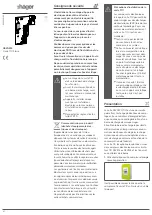
Chapter 6: IP Core Interfaces
6–17
Avalon-ST TX Interface
November 2012
Altera Corporation
Arria V GZ Hard IP for PCI Express
Avalon-ST TX Interface
describes the signals that comprise the Avalon-ST TX Datapath. The TX data
signal can be 64, 128, or 256 bits.
Table 6–5. 64-, 128-, or 256-Bit Avalon-ST TX Datapath (Part 1 of 4)
Signal
Width
Dir
Avalon-ST
Type
Description
tx_st_data
64,
128,
256
I
data
Data for transmission. Transmit data bus. Refer to
through
Figure 6–18
for the mapping of TLP packets to
tx_st_data
and examples of the timing of this interface. When
using a 64-bit Avalon-ST bus, the width of
tx_st_data
is 64.
When using a 128-bit Avalon-ST bus, the width of
tx_st_data
is
128 bits. When using a 256-bit Avalon-ST bus, the width of
tx_st_data
is 256 bits. The Application Layer must provide a
properly formatted TLP on the TX interface. The mapping of
message TLPs is the same as the mapping of Transaction Layer
TLPs with 4 dword headers. The number of data cycles must be
correct for the length and address fields in the header. Issuing a
packet with an incorrect number of data cycles results in the TX
interface hanging and becoming unable to accept further
requests.
tx_st_sop
1, 2
I
start of
packet
Indicates first cycle of a TLP when asserted together with
tx_st_valid
.
When using a 256-bit Avalon-ST bus with
Multiple packets per
cycle
, bit 0 indicates that a TLP begins in tx_st_data[127:0], bit 1
indicates that a TLP begins in tx_st_data[255:128].
tx_st_eop
1, 2
I
end of
packet
Indicates last cycle of a TLP when asserted together with
tx_st_valid
.
When using a 256-bit Avalon-ST bus with
Multiple packets per
cycle
, bit 0 indicates that a TLP ends with tx_st_data[127:0], bit 1
indicates that a TLP ends with tx_st_data[255:128].
1
O
ready
Indicates that the Transaction Layer is ready to accept data for
transmission. The core deasserts this signal to throttle the data
stream.
tx_st_ready
may be asserted during reset. The
Application Layer should wait at least 2 clock cycles after the
reset is released before issuing packets on the Avalon-ST TX
interface. The
reset_status
signal can also be used to monitor
when the IP core has come out of reset.
If
tx_st_ready
is asserted by the Transaction Layer on cycle
<n>,
then
<n +
readyLatency>
is a ready cycle, during which
the Application Layer may assert
valid
and transfer data.
When
tx_st_ready
,
tx_st_valid
and
tx_st_data
are
registered (the typical case), Altera recommends a
readyLatency
of 2 cycles to facilitate timing closure; however, a
readyLatency
of 1 cycle is possible. If no other delays are
added to the read-valid latency, the resulting delay corresponds
to a
readyLatency
of 2.
















































